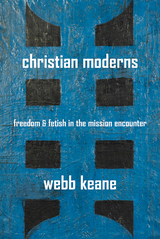 Webb Keane’s central claim in Christian Moderns, if I understand correctly, is that this modern Euro-American culture is characterized by a certain “semiotic ideology” that is, in turn, embedded in a certain historical narrative. Specifically, it rests on a certain view of moral agency which is, in turn, authorized by an emancipatory philosophy of history. Keane further argues that Reformed Protestantism contributed to this historical formation by encouraging a more individualistic, internalist and creedal reconfiguration of the religious and by conceptualizing conversion as a process of emancipation, purification and de-fetishization.
Webb Keane’s central claim in Christian Moderns, if I understand correctly, is that this modern Euro-American culture is characterized by a certain “semiotic ideology” that is, in turn, embedded in a certain historical narrative. Specifically, it rests on a certain view of moral agency which is, in turn, authorized by an emancipatory philosophy of history. Keane further argues that Reformed Protestantism contributed to this historical formation by encouraging a more individualistic, internalist and creedal reconfiguration of the religious and by conceptualizing conversion as a process of emancipation, purification and de-fetishization.
As such, Christian Moderns is part of an expanding, interdisciplinary discourse about liberalism, modernism and secularism. Within anthropology, the key figure in this discourse is, of course, Talal Asad, who figures centrally in Keane’s account. Within philosophy, one naturally thinks of Charles Taylor, who is also frequently cited. But one thinks, too, of Alasdair MacIntyre and Jean Elshtain. Turning to theology, Stanley Hauerwas and John Milbank come to mind.
Christian Moderns nonetheless stands apart in at least two respects: in method and in conceptualization. Whereas the foregoing works mainly employ a historical and critical approach that contrasts the modern West with its premodern self and its heterodox variants, Keane works mainly comparatively, using the Indonesian mission encounter to unearth the doxa of modern Euro-American culture. Further, whereas Asad relies mainly on the genealogical strategies of Foucault and Nietzsche, Keane adds Latour’s theory of “purification” and “hybridity.” In reading the semiotic ideology of the Sumbanese as a form of fetishism, which attributes agency to words and things, Keane argues, the Dutch Calvinist missionaries are compelled to articulate their own semiotic ideology, which views authentic moral agency as arising out of a self-conscious disentanglement of an immaterial and interior self from all forms of the material and the external. But this process of purification is necessarily incomplete. Humans, after all, are social and physical creatures. Thus, processes of purification inevitably give rise to new forms of hybridity—in this case, to new texts, rituals, incantations and so on, either directly, in the form of routinized religious practices or, indirectly, in the form of heterodox religious movements, such as Pentecostalism.
On all these counts, Keane’s account of purification is remarkably consistent with those set forth by the philosophers and theologians. With Taylor’s accounts of excarnation and the buffered self; with Elshtain’s account of autonomization and sovereignty; with MacIntyre’s ferocious attack on the putative invulnerability of the liberal self, and so on. On two other counts, however, it goes beyond and even challenges them. First, by highlighting the role of colonial encounters in the purification process. And second, by emphasizing the role of missionary work, not simply in spreading Western religion, but, paradoxically, in diffusing Western secularism as well. As such, Keane’s account subtly pushes back against theories of “multiple modernities,” which tend to portray “world civilizations” as bounded entities evolving independently in accord with their own “cultural logics.”
That said, Keane’s comparative approach does have the inevitable weaknesses and blind-spots, and these emerge clearly in the contrast with the more historical and critical works of Taylor and company. By tracing out the historical genesis of modern conceptions of moral agency, Taylor and company are able to isolate multiple turning points in the genesis of modern secularism including: Ockhamist nominalism, the neo-Epicurean transvaluation of natural law theory by Grotius, Hobbes and Hume, the disenchantment of the cosmos via providential deism, the sacralization of the state in Rousseauian republicianism and its Jacobin offshoots, the aestheticization of the self in late Romanticism and so on. Keane is of course well aware of this weakness and of the incompleteness of his account. But he seems less aware of the crucial blind-spot: the existence and persistence of competing semiotic ideologies and rival visions of moral agency within the Euro-American tradition. For MacIntyre, Hauerwas, Elshtain, Milbank and Taylor critique modern liberal secularism not from without, but from within, by drawing variously on Aristotle, Augustine and Aquinas. Amongst many other things, they argue that moral agency is necessarily embodied via the cultivation of virtue; that tradition is not the opposite of rationality; and that worldly sovereignty must not be monopolized by the secular state. In other words, they dispute the central tropes of modern, liberal secularism. Keane, by contrast, eschews critique of this sort, preferring instead to raise the semiotic ideology of Euro-American culture to greater self-consciousness. To that degree, however, he remains a captive to the very ideology he wishes to critique, since increased self-consciousness as an end in itself is, after all, one of the governing tropes of moral agency in the West. Does this mean that prophetic critique is the only possible form that a critique of secularism can take? That one must be a theist to be a critic in our secular age? By no means. Political philosophers such as Quentin Skinner, Phillip Pettit and Michael Sandel, amongst others, have elaborated a powerful neo-republican critique of modern liberalism. William Connolly, meanwhile, has used Nietzsche and James to develop a theory of “deep pluralism” that is neither secularist nor theist. Even Jürgen Habermas, that icon of Euro-American enlightenment, has recently urged his partisans to recognize the untapped “semantic potentials” and “moral resources” still contained within religious languages and communities. In his call for a post-secularist philosophy, Habermas seems to be heralding the emergence of new hybridities. If so, perhaps the latest wave of purification has crested.











